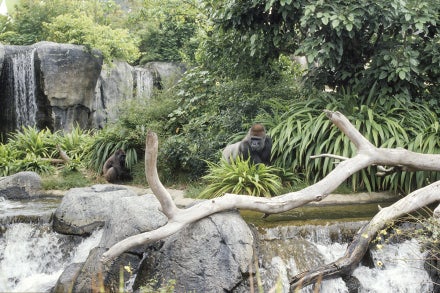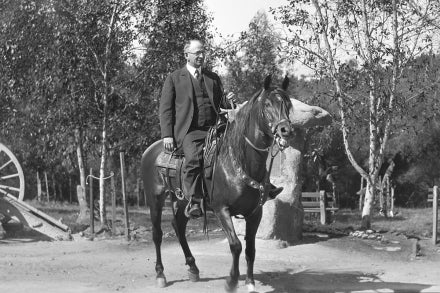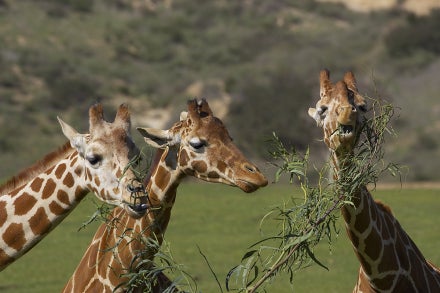FOR IMMEDIATE RELEASE
CONTACT:
San Diego Zoo Wildlife Alliance
Public Relations
619-685-3291
publicrelations@sdzwa.org
sdzwa.org
NEWS RELEASE
Andean Bear Cub Twins Born at the San Diego Zoo—a First in Nearly 30 Years—Are Venturing Out of Their Den to Explore Guest-facing Habitat
The Cubs’ Arrival is Significant for Conservation of Their Elusive, Vulnerable Species
SAN DIEGO (March 14, 2023) – The San Diego Zoo continues to celebrate the arrival of twin Andean bear cubs—now 3 months old and venturing out of their private den into the guest-facing habitat. The cubs were born in December 2022 to second-time mother Alba, and sire Turbo. Since the twins’ birth, wildlife care specialists have been closely observing the bears via a closed-circuit video camera and an audio “baby monitor,” allowing Alba to care for her youngsters without interruption until they were ready to leave the den.
The arrival of Alba’s cubs marked the first time that twin Andean bear cubs have been born at San Diego Zoo since 1993—when Alba’s grandmother, Houdini, gave birth to twins Sombra and Quixote. Alba previously gave birth to a male cub named Agapito in 2020—and he was the first Andean bear cub born at San Diego Zoo since 1993.
“We couldn’t be more thrilled about the birth of Alba’s twin cubs,” said Tammy Batson, lead wildlife care specialist at the San Diego Zoo. “We witnessed Alba transition beautifully into motherhood with her first cub a couple of years ago, and now as a second-time mother with twins, she continues to impress us with her attentiveness. She’s a proven mom, who now has both hands full.”
Like other newborn bears, Andean bear cubs are helpless and entirely dependent on their mothers. Alba cared for and bonded with her cubs in their den for the first few months, behind their guest-facing habitat and off public view. In their native South American forests, Andean bear cubs typically leave their dens at around 3 months of age and are believed to remain close to their mothers for at least the first year. Wildlife care specialists continue to monitor Alba and her cubs, who have access to both their den and outdoor habitat.
Andean bears were first cared for at the San Diego Zoo in 1938, and since then, 11 cubs have been born. A female gives birth to one, two or rarely three cubs in an isolated den, but it is not known how she chooses her den. The limited information available suggests they choose dens in unusually rugged areas. All maternal dens discovered so far have been similar to nests, on the ground or in cavities below rocks. Andean bears are the last remaining relative of the extinct giant short-faced bear, and are the only bear species native to South America.
The Andean bear is listed as Vulnerable on the International Union for Conservation of Nature Red List of Threatened Species. The main threats to this species are habitat loss and fragmentation, challenges to human-wildlife coexistence and poaching. Andean bear habitat is being lost at a rate of approximately 2–4% per year due to climate change, mining and lumber operations, and farming. The bears are protected by international trade laws, but they are still illegally hunted for their meat, fat and body parts. It is unclear how many bears remain in their native habitat, with estimates ranging from 2,500 to 10,000 adults.
The birth of these two cubs is significant for conservation research. Although Andean bears are typically diurnal, very little is known about them in their native habitat, because of their shy nature and tendency to avoid people. The bears are native to Andes mountain countries from Venezuela to Bolivia, typically living in dense and rugged forests, as well as grasslands and scrublands. San Diego Zoo Wildlife Alliance now has yet another opportunity to learn more about the interactions between a mother and her cubs, as well as cub development. Andean bears in human care serve as a safety net for dwindling populations in native habitats, and give biologists a chance to answer a myriad of biological questions about the species, develop noninvasive methods for use in field conservation work, and better understand Andean bear physiology and behavior, to support the population.
San Diego Zoo Wildlife Alliance has been studying Andean bears for over 14 years, and since 2008 has worked with various partners to research and conserve bears in Peru. Collaborative work is underway on the Manu landscape of southeast Peru to document Andean bear presence and characterize critical aspects of bear ecology and behavior—such as foraging behavior, trail use and marking behavior—to determine where these bears live, and how they interact with their environment and plants in their varied habitats. Additional work focuses on genetic diversity across Colombia, Ecuador and Peru—a large portion of the species’ range. To enhance future conservation research and planning, San Diego Zoo Wildlife Alliance provides opportunities, mentorship and ecological training for technicians and students in and around Peru.
###
About San Diego Zoo Wildlife Alliance
San Diego Zoo Wildlife Alliance is a nonprofit international conservation leader, committed to inspiring a passion for nature and working toward a world where all life thrives. The Alliance empowers people from around the globe to support their mission to conserve wildlife through innovation and partnerships. San Diego Zoo Wildlife Alliance supports cutting-edge conservation and brings the stories of their work back to the San Diego Zoo and San Diego Zoo Safari Park—giving millions of guests, in person and virtually, the opportunity to experience conservation in action. The work of San Diego Zoo Wildlife Alliance extends from San Diego to eco-regional conservation “hubs” across the globe, where their expertise and assets—including the renowned Wildlife Biodiversity Bank—are able to effectively align with hundreds of regional partners to improve outcomes for wildlife in more coordinated efforts. By leveraging these skills in wildlife care and conservation science, and through collaboration with hundreds of partners, San Diego Zoo Wildlife Alliance has reintroduced more than 44 endangered species to native habitats. Each year, San Diego Zoo Wildlife Alliance’s work reaches over 1 billion people in 150 countries via news media, social media, their websites, educational resources and the San Diego Zoo Wildlife Explorers television programming, which is in children’s hospitals in 13 countries. Success is made possible by the support of members, donors and guests to the San Diego Zoo and San Diego Zoo Safari Park, who are Wildlife Allies committed to ensuring all life thrives.



